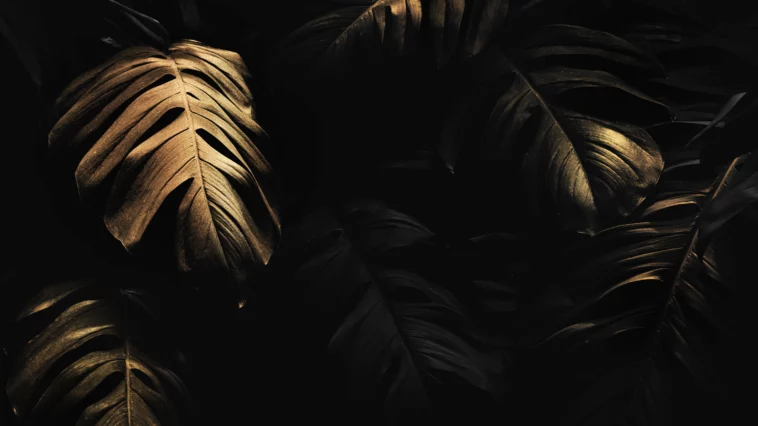Maybe you’re thinking to yourself, “I love Monstera, but I don’t know anything about monsteras.” Or maybe you have a Monstera that’s not doing well and you find yourself asking, “How do you prevent monstera from browning?” No matter where you fall on the scale of seasoned Monstera grower to complete beginner, these tips will keep your plant thriving.
To prevent Monstera from browning, water it only when the potting soil is 70–80% dry and keep it away from any chilly areas. In addition, keep your Monstera at a humidity level of 60% or above, and avoid placing it in direct sunlight.
It’s upsetting to watch your monstera leaves get brown, but there are ways to prevent it from browning.
Browning may be caused by a variety of factors including over-fertilization and poor nutrition as well as sunburn and transplant shock. Additionally, inconsistencies in watering, physical damage to the plant, as well as a lack of sunlight are all potential reasons.
A dry potting soil is essential before watering the Monstera. Keep your monstera out of direct sunlight and at a humidity level of 60% at all times.
Read More: Monstera Leaves Care – A Complete Guide
Table of Contents
Overwatering
When watering your Mostera plant, you must be cautious not to overwater it, since it will die if it gets too much water.
Excessive water, given too often and in huge amounts, would damage the roots and lead them to stop functioning altogether.
The constant presence of moisture suffocates the root system, preventing it from receiving adequate oxygen to thrive. The root cells die gradually and can no longer function effectively.
Fungus thrives in an environment with too much water surrounding the root system, and this fungus is the major cause of the root rot disease.
When roots get rotted, they become unable to absorb the water or even other nutrients, resulting in discoloration of the leaves, which may turn yellow or brown in certain cases.
Symptoms of Overwatered Monstera
- Brown spots on the foliage.
- Wet soil and a wilting Monstera.
- There is a yellowing and browning of the stems and leaves.
- The soil has a strong odor.
- Mold is developing on the top of the soil.
- The leaves are wilted, mushy, or limp.
- The soil surface is usually damp.
- Roots that have become soft and brown. The root system may be easily removed.
How to Resolve Overwatering Challenges
- Remove and discard the brown leaves.
- Examine the root system of your monstera by removing it from its pot. remove the dirt by rinsing the area well.
- Look for mushy roots in the root system.
- Remove the decaying roots with sterilized shears.
- Using a hydrogen peroxide solution, disinfect what’s left of the roots. Dilute a 3% hydrogen per oxide solution with water in a 1:3 ratio.
- Allow the plant to fully dry out in a cool, dry spot for 6-8 hours.
- Add fresh potting soil to the plant’s current container. If you wish to utilize the old pot, clean it with boiling water.
How can I tell if my Monstera is thirsty and needs a drink? You can tell whether you need to water your Monstera by doing a finger test every week.
Dig 1-2 inches into the soil to find out how much moisture there is. Reduce your watering schedule if you sense wetness. Give your monstera a drink if the soil seems dry.
On the other side, a watering meter may be quite helpful. It will let you figure out how much water your soil has. You’ll be able to tell when it’s time to water your plant this way.
How do I water my Monstera and prevent it from browning? Preventing drought conditions and overwatering requires consistency.
Make sure your soil is well drained. This might cause the leaves to turn brown.
Also, with your monstera, be sure to choose soil that drains properly.
In the winter, Monstera needs less watering; just put it in a warm place. Most houseplants are in dormancy at this time of year.
Read More: why are my monstera leaves turning brown
Lighting issues
Direct sunlight is not recommended for your Monstera, which prefers bright light. Exposing your Monstera to direct sunlight would result in sunburn.
When keeping Monstera in a southern room, sunburn is the most typical problem.
But if you don’t give your monstera enough light, it will get brown and generate shorter leaves. Chlorophyll, the green pigment that gives leaves their color, is essential for the plant’s ability to create food.
You may not be able to maintain your monstera’s foliage healthy if it isn’t receiving enough sunlight. The monstera’s leaves become brown and yellow as a consequence.
How To Fix Lighting Issue
- The brown leaves must be removed.
- Put your Monstera in a west or east-facing window to get the greatest effects. Keep in mind that bright, indirect light is best for your Monstera.
- From a south-facing window, keep your monstera at least 5 to 6 feet away (1-2 m). So, it just gets a little bit of sun.
- A sun-blocking curtain should also be used on a south-facing window. Hopefully, this will keep your monstera in check.
- Your plant should not be left outdoors unless it has been used to the environment.
- Keep your monstera happy and healthy by using artificial lighting if you do not have access to natural light in your room.
Read More: why is my monstera turning brown
Dry Soil
As a result of its natural tendency to grow on tree trunks and climb on them, Monstera can endure some drought. Aerial roots and other processes help it absorb water from the atmosphere.
Because soil nutrients are water soluble, plants need water to absorb their nutrition. The xylem tissue distributes nutrients from the root system to the rest of the plant.
Water is required for the whole process, and plant cannot continue the regular physiological function without it.
Monstera leaf cells will die as a consequence, leaving them open to attack by pests and pathogens. The browning of the leaves is the outcome of all of the acts that have taken place.
Symptoms of underwatered Monstera
- Mostera’s Sings of Underwatering
- The edges and tips of the leaves get brown and crispy when water cannot reach the leaves’ furthest regions.
- The browning and curling of Monstera leaves are classic symptoms of soil dryness.
- In this case, the potting soil will be entirely dry, and the pot will seem lightweight in comparison.
- Leaves will show signs of drooping.
How to Fix Underwatered Monstera
- A thorough soak in water is required for heavy underwatered monstera. Put the pot in a sink that has running water.
- Another option is to completely soak the pot with water ensuring that the water drains via the drainage holes.
- Continue to water the soil until it is saturated.
- Once the top 1-2 inches of soil are fully dry, water your monstera once more.
Diseases
If a Monstera becomes brown, it may be an early sign of a disease. The browning of your plant might be caused by a number of different diseases.
Eyespot disease: A fungal infection recognized as eyespot disease may cause brown leaves on a leaf, which indicates that the leaf is affected with the disease.
Anthracnose: Anthracnose may also be caused by fungi. This disease is more likely to infect your plant if it has a wound. Your Monstera plant will initially become yellow, then brown, before dying in this situation.
Signs of Fungal Disease on Monstera Leaves
- Monstera leaves have brown patches with yellow edges.
- Spots of rust on the leaves
- Yellow and white spots emerge on the leaves.
How to Resolve Disease Issues
- Use sterilized scissors to remove the diseased leaves.
- Spray baking soda on the diseased leaves. A standard baking soda spray is made by adding one teaspoon of baking soda to one quart of water.
- Fungi grow in moist circumstances, so keep your leaves dry for a while to resolve the problem.
- Make sure your plant receives enough humidity. Fungal infection is facilitated by low humidity.
- You should also check any other plants in the nearby area for disease if there are any. This will assist you in discovering the root of the issue.
Temperature Stress
Monsteras are tropical plants that thrive in temperatures ranging from 20–86 degrees Fahrenheit (68–72 degrees Celsius).
Your Monstera plant may turn brown if it experiences a rapid drop in temperature or is exposed to extreme weather conditions.
The sensitive leaf cells are damaged when the ambient temperature drops suddenly, resulting in browning of the foliage. The degree of the damage will be determined by the amount of time spent in the cold.
Cold breezes may cause substantial harm to the plant’s leaves if it is put on a terrace or outside of a room.
Additionally, the leaves are damaged by the cold bite induced by direct airflow from the air conditioner.
If the plant is near a window, it may potentially be damaged by a cold draft that comes via the window.
How To Fix Temperature Issue
- In the winter, be sure to keep your plants warm. If your room is becoming too chilly, just shift your monstera to a more comfortable spot. The conservatory or unheated sunroom is not a good place to keep your Monstera plant during the winter months.
- Do not place your Monstera plant near radiators or air conditioners, since they might damage it. Additionally, avoid placing your plant near windows that are too hot or too cold. Monstera may suffer serious harm if exposed to very high temperatures.
Low humidity
For its whole existence, your Monstera plant has been exposed to high levels of humidity. Its leaves may turn brown due to insufficient humidity.
the stromata of the leaves of your Monstera plant is affected by low humidity, causing the plant to lose water. Therefore, monstera demands far more water than normal.
Constantly low humidity results in dehydration symptoms. The leaf tips curl and become brown as they dry out.
Most houseplants want a relative humidity of 50-60%.
How to Fix Low Humidity
There are ways to keep your Monstera leaves from drying out if you reside in an area with a dry climate.
- A humidifier may help you keep your plants at the appropriate humidity level. Keep your humidity level about 60% if you want to see the most growth and the most gorgeous leaves.
- It’s also possible to reposition your plant. Look around your house for an area where the humidity is higher and the light is brighter. Our bathrooms are often more humid than the rest of the house. This is due to the moist atmosphere formed by the shower & sinks!
- It may also be beneficial to group your plants together or to place them in water-filled pebble trays to alleviate humidity problems.
- You may also increase humidity by misting. Just spray the leaves of your monstera with water. Do this numerous times a day to keep the humidity at its ideal level. However, I dislike this technique since it raises the risk of fungal infection.
Over-fertilizing
Brown Monstera leaves may also be caused by overfertilizing. If you overfeed your Monstera plant, you’ll notice a variety of symptoms, including brown or black foliage.
It’s possible that your plant will show signs of both nutritional deficiency and overnutrition at the very same time.
The root system may be damaged by too much fertilizer, stopping your plant from absorbing nutrients and water.
As a result, the leaves of your monstera may become yellow or brown.
How To Fix Over-fertilization Issue
- Before you begin fertilizing, it is vital to have a look at how much you have already fertilized. Check for salt stakes to accomplish this.
- Next, thoroughly rinse your soil with water to remove any remaining salt.
- For the following three months, refrain from fertilizing your soil to avoid the issue from occurring.
- Your plant will thank you if you provide it with the right lighting, watering and humidity conditions.
- Alternatively, you may want to repot your Monstera. Repotting may be stressful for your plant, so this should be your final resort.
Transplant Shock
Your monstera’s rapid expansion is a thrilling sight to see. You’ll have to repot them at some point since they outgrow their original container.
It’s possible that your monster will get damaged during the transplant if you don’t do it properly. Even with the greatest care, some of the roots are fragile and may be harmed.
The root system of your monster will also take some time to adapt itself in its new habitat. This time of transition is known as transplant shock, and it causes your monster leaves to droop and brown
How To Fix Transplant Shock Issue
Your only option if your plant is already suffering from the effects of transplant shock is to give it best possible care.
- Make sure your plant has plenty of drainage holes.
- Make room for fresh growth by removing all dead leaves and stems.
- For a few months, don’t feed your plant any fertilizer. It’s possible that fertilizer may put your plant under even greater strain.
- If you’ve relocated your houseplant and it’s gone brown, it’s possible that it’s not receiving enough light or humidity in its new location. It is as simple as returning your plant to where it was before you transplanted it.
- Make sure your Monstera plant are getting enough water. At this stage, overwatering might harm your Monstera.
Physical Damage
Make sure not to hurt your Monstera by touching it every morning, even though it seems like a lovely way to start your day.
Eventually, your monstera would turn brown.
Changing the location of your monstera might also hurt it. So be cautious while performing this kind of thing.
Your pet is yet another potential source of physical harm. I know it seems strange, but your pet may be to blame for this beautiful plant’s destruction.
How To Fix Physical Damage
- Please avoid touching your plants too much, particularly the young ones.
- When transplanting, be sure to follow each step to the letter.
- Check to ensure that your pets can’t get to your monstera. Additionally, it is important to bear in mind that monstera is somewhat harmful to both pets and people.
- You may raise the plant pot to keep it out of the reach of your pets.
- Another option is to teach your pets not to destroy your houseplants.
Conclusion
How Do You Prevent Monstera From Browning?
- Trim the Monstera base to remove any brown or dead leaves. Because they will never heal or become green, the discolored edges should be removed.
- After ensuring that the soil is dry, water your plant. In addition, I recommend giving your plant more frequent waterings.
- Depending on the kind of potting mix, light, temperature, container size, and pot type, the amount of water your plant need or how quickly the soil dries up might vary greatly. It is more important to determine how dry the soil should be before watering it rather than how frequently.
- The soil should be checked if you feel that your Monstera is overwatered. Repot your plant if required in a new soil mixture for potting.
- The bright sunlight causes the leaves to burn and become brown when they are kept outside. Change its placement if it gets too much direct sunlight in its present position.


